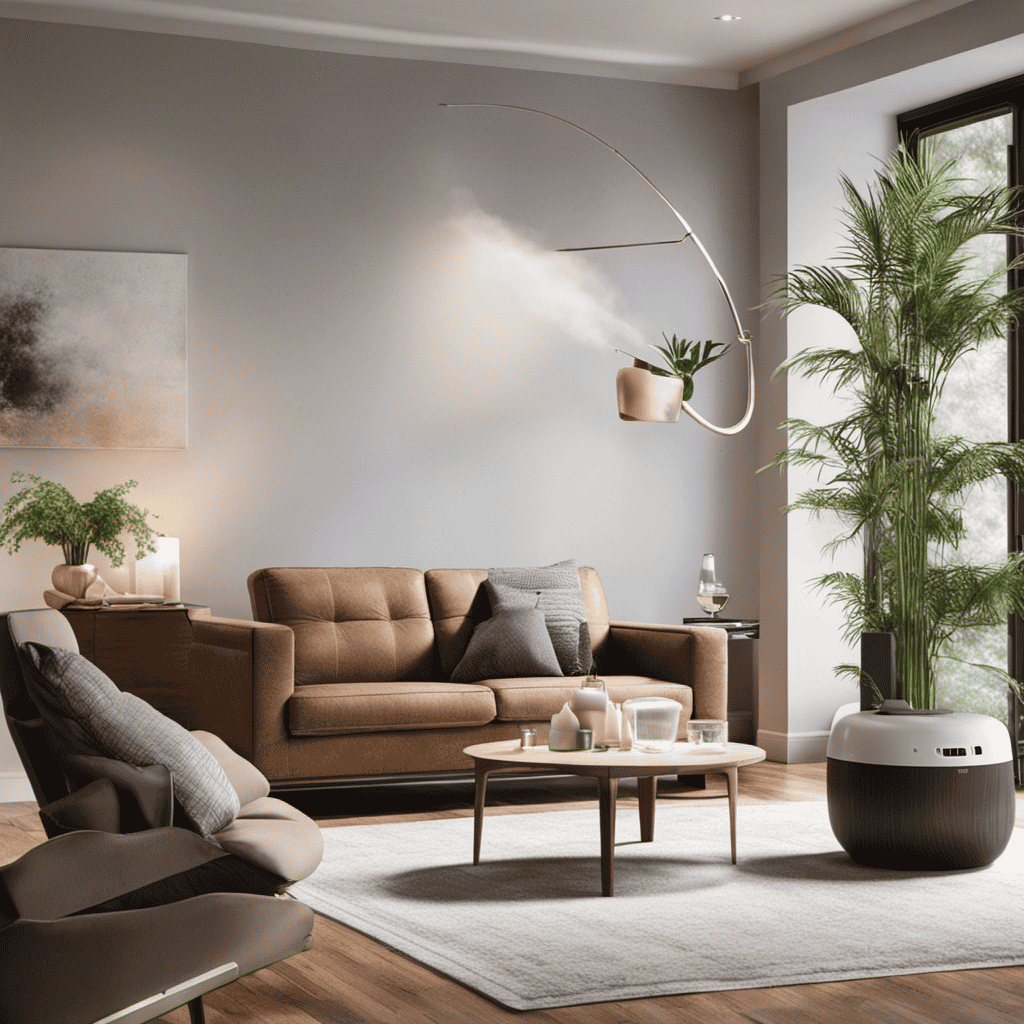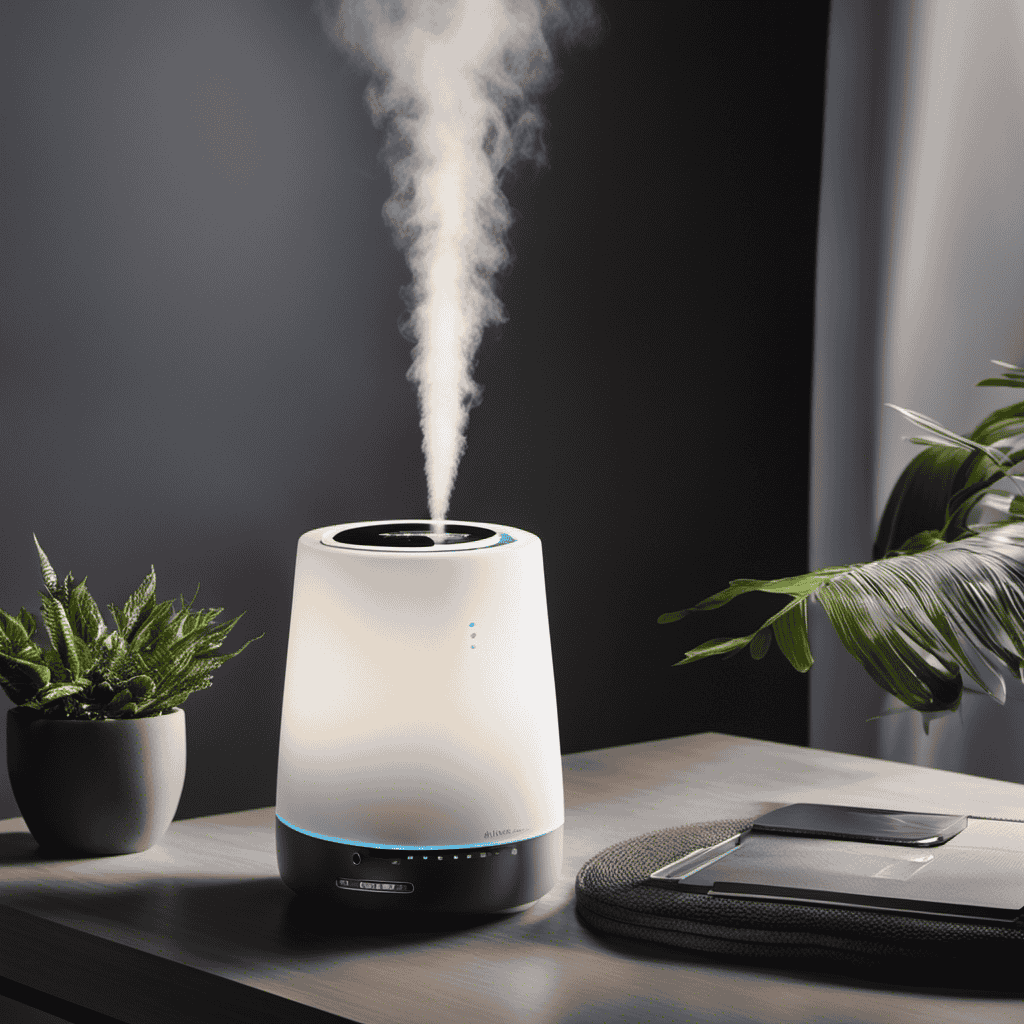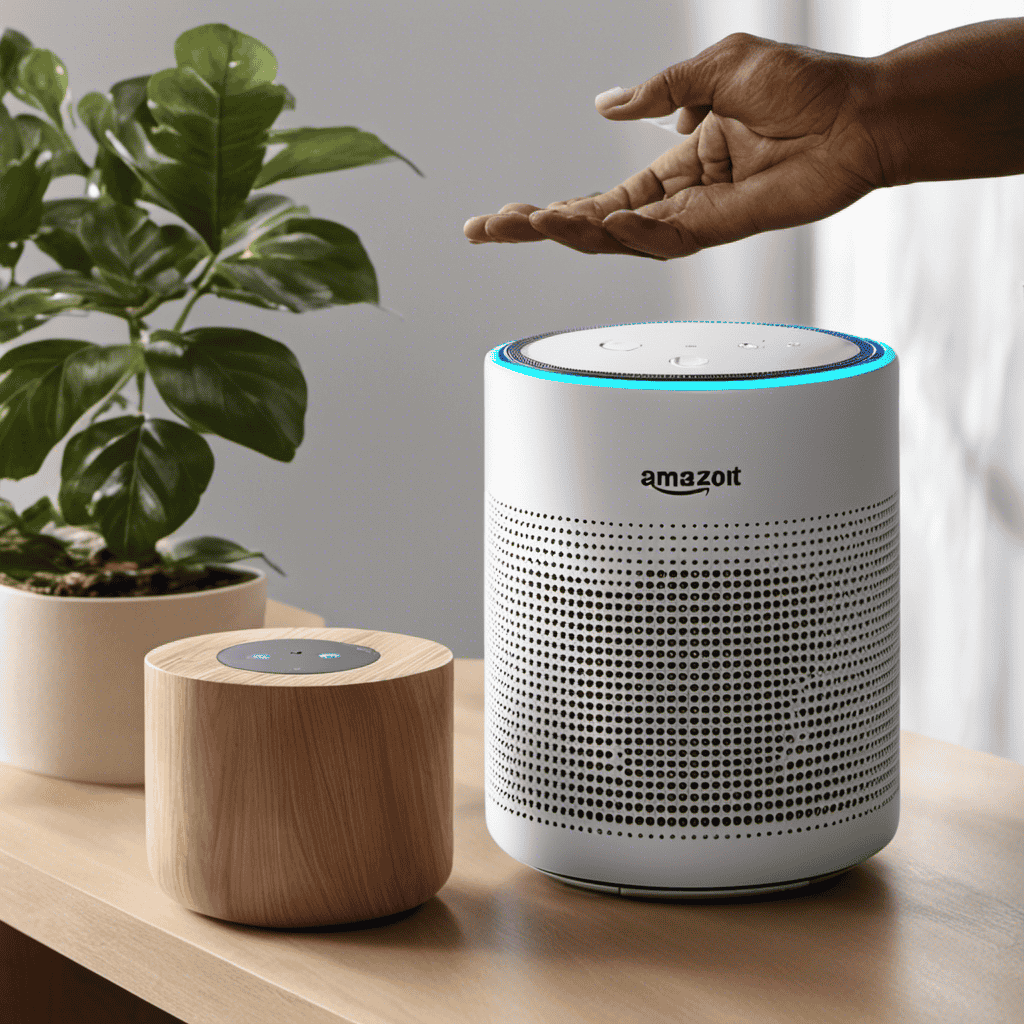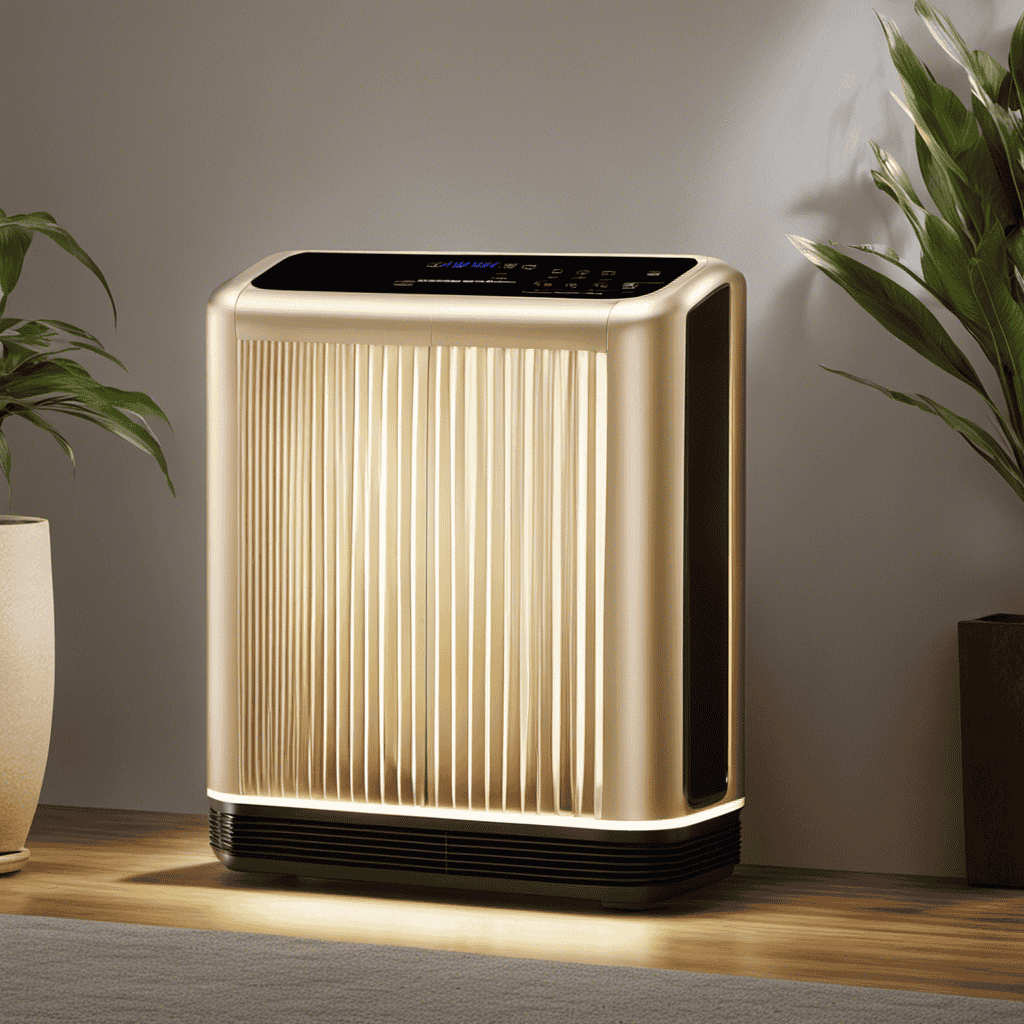I have always wondered about the distinction between a humidifier and an air purifier. It appears that these gadgets are frequently confused, but is there actually a difference?
In this article, I will dive deep into the purpose, functionality, benefits, and factors to consider when choosing a humidifier or an air purifier. By the end, I hope to provide a thorough and objective understanding of these devices, and perhaps debunk some common misconceptions along the way.
Key Takeaways
- A humidifier adds moisture to the air and helps alleviate dry skin and respiratory problems, while an air purifier removes pollutants and improves air quality.
- Humidifiers offer different humidity level settings and use evaporative, ultrasonic, or steam methods to distribute moisture effectively.
- Air purifiers remove impurities from the air using filters, electrostatic precipitation, or UV light, while humidifiers do not have a specific filtration mechanism.
- Using a humidifier can relieve respiratory issues and prevent dryness, while an air purifier removes pollutants and allergens to create a healthier living environment.
Purpose of a Humidifier
If you’re looking to add moisture to the air in your home, a humidifier can help with that. A humidifier works by releasing water vapor into the air, increasing the moisture content and raising the humidity levels. This is especially beneficial during dry winter months or in arid climates where the air tends to be drier. By maintaining proper humidity levels, a humidifier can alleviate dry skin, chapped lips, and irritated nasal passages. It can also help reduce the occurrence of respiratory problems such as allergies, asthma, and sinus infections. However, it’s important to note that a humidifier should be used responsibly to avoid excessive moisture, which can lead to mold and mildew growth.
Now, let’s explore the purpose of an air purifier.
Purpose of an Air Purifier
The purpose of an air purifier is to remove pollutants and improve air quality. Air purifiers are designed to capture and eliminate harmful particles such as dust, pollen, pet dander, and smoke from the air we breathe. By removing these pollutants, air purifiers can greatly benefit respiratory health and reduce the risk of allergies and asthma attacks.
Air purifiers also help in maintaining the humidity levels in the air, which is crucial for a healthy living environment. Dry air can cause various respiratory issues, dry skin, and even worsen existing conditions like asthma. By improving air quality and maintaining optimal humidity levels, air purifiers play a significant role in enhancing overall well-being.
Now, let’s move on to explore the functionality of humidifiers.
Humidifier Functionality
When it comes to maintaining a comfortable indoor environment, humidity level control plays a crucial role.
By using a humidifier, I can adjust the moisture in the air to an optimal level, preventing dryness and promoting a healthier atmosphere.
This not only benefits my overall comfort but also helps to moisturize my respiratory system, reducing the risk of respiratory issues such as dry throat, coughing, and congestion.
Humidity Level Control
Maintaining a consistent humidity level is important for both comfort and health. Humidity level maintenance refers to the process of controlling and regulating the amount of moisture present in the air.
High humidity can have several negative effects on our well-being. Excessive moisture in the air can lead to the growth of mold and mildew, which can trigger allergies and respiratory issues. It can also create a breeding ground for dust mites and other pests.
Moreover, high humidity can make us feel uncomfortable and sweaty, especially during hot weather. It can also cause damage to furniture, electronics, and other household items.
Therefore, it is crucial to monitor and control the humidity levels in our living spaces to ensure a healthy and comfortable environment.
Moisturizing Respiratory System
To keep your respiratory system moisturized, try using a humidifier in your living space. Here are three moisturizing benefits of using a humidifier:
-
Relieves dryness: Dry air can cause irritation and dryness in the respiratory system, leading to symptoms like coughing, sore throat, and dry nasal passages. By adding moisture to the air, a humidifier helps alleviate these symptoms and keeps the respiratory system hydrated.
-
Improves respiratory health: Dry air can exacerbate respiratory conditions such as asthma and allergies. By maintaining an optimal level of humidity in the air, a humidifier can help reduce the frequency and severity of respiratory symptoms, promoting better respiratory health.
-
Prevents infections: Dry air can make the respiratory system more vulnerable to infections, as the dry conditions can impair the body’s natural defense mechanisms. By adding moisture to the air, a humidifier helps create an environment that is less conducive to the growth and spread of bacteria and viruses, reducing the risk of respiratory infections.
Using a humidifier can greatly improve your respiratory health by providing moisture to the air and preventing dryness and irritation.
Air Purifier Functionality
One key feature of air purifiers is that they can effectively remove impurities from the air, such as dust, pollen, and pet dander. Air purifiers accomplish this by utilizing various air purification techniques.
These techniques include HEPA filtration, activated carbon filters, and UV-C light technology. HEPA filters capture tiny particles, such as allergens and pollutants, while activated carbon filters absorb odors and chemicals. UV-C light technology, on the other hand, kills bacteria and viruses by damaging their DNA. Additionally, some air purifiers use ozone generators to eliminate odors and destroy airborne pollutants.
These humidity control methods and air purification techniques work together to create cleaner and healthier indoor air.
Now, let’s explore the benefits of using a humidifier in the next section.
Humidifier Benefits
Using a humidifier can help alleviate dryness in the air, making it easier to breathe and reducing symptoms such as dry skin and congestion. Here are three ways a humidifier benefits your respiratory health and moisture balance:
-
Relieves respiratory issues: Dry air can irritate the respiratory system, causing coughing, wheezing, and even exacerbating conditions like asthma. By adding moisture to the air, a humidifier helps soothe the airways, reducing inflammation and promoting better breathing.
-
Prevents dryness: Dry air can lead to dry skin, chapped lips, and dry nasal passages, which can be uncomfortable and even lead to nosebleeds. A humidifier restores moisture to the air, keeping your skin hydrated and your nasal passages moist, preventing these issues.
-
Enhances sleep quality: Dry air can cause discomfort during sleep, leading to snoring and a restless night. A humidifier adds moisture to the air, creating a more comfortable sleep environment, promoting better sleep quality.
Air Purifier Benefits
Improve the quality of the air you breathe with an air purifier, which helps remove pollutants and allergens for a healthier living environment. Air purifiers use advanced technology to filter the air, capturing small particles that can cause respiratory problems. They are effective in removing dust, pollen, pet dander, mold spores, and even bacteria and viruses. By reducing these airborne contaminants, air purifiers can greatly improve indoor air quality and provide relief to those suffering from allergies or asthma.
Here is a table that highlights the benefits of air purifiers:
| Benefits of Air Purifiers |
|---|
| Removes pollutants |
| Eliminates allergens |
| Reduces respiratory issues |
Air purifiers work by using different types of filters, such as HEPA (High Efficiency Particulate Air) filters, activated carbon filters, and UV-C light technology, to capture and neutralize harmful particles. They can be used in various settings, including homes, offices, and hospitals, to create a healthier and more comfortable environment. With advancements in air purifier technology, there are now many options available to suit different needs and preferences. So, if you want to breathe cleaner air and improve your overall well-being, investing in an air purifier is a wise choice.
Differences in Humidity Control
When it comes to controlling humidity levels, there are two key factors to consider: humidity level settings and moisture distribution methods.
Humidity level settings refer to the ability to adjust the amount of moisture in the air, allowing for optimal comfort and health.
Moisture distribution methods, on the other hand, determine how this moisture is distributed throughout the space, ensuring even and effective coverage.
These two factors work hand in hand to create a balanced and controlled indoor environment.
Humidity Level Settings
The humidifier’s settings include different humidity levels to choose from. This allows me to control the amount of moisture in the air according to my preferences and needs.
Here are three moisture distribution methods commonly used by humidifiers:
-
Evaporative: This method uses a fan to blow air through a water-soaked filter or wick, which then evaporates and adds moisture to the air.
-
Ultrasonic: In this method, a piezoelectric transducer vibrates at an ultrasonic frequency, creating tiny water droplets that are released into the air as a fine mist.
-
Steam: Steam humidifiers heat water to create steam, which is then released into the air to increase humidity levels.
Moisture Distribution Methods
Using different moisture distribution methods, humidifiers can control the amount of moisture in the air according to personal preferences and needs. Humidity control methods play a crucial role in improving air quality and maintaining a comfortable indoor environment. There are various techniques utilized by humidifiers to distribute moisture effectively.
One of the common methods is the evaporative process. This involves a fan blowing air over a moistened wick or filter, causing the water to evaporate and humidify the air. Another method is the ultrasonic technology, where a vibrating diaphragm creates small water droplets that are then released into the air. Additionally, there are steam humidifiers that boil water and release steam into the air, increasing its moisture content.
These humidity control methods offer flexibility and allow individuals to customize the humidity levels in their surroundings. By using these techniques, humidifiers can effectively improve air quality and create a more comfortable living environment.
| Moisture Distribution Method | Description |
|---|---|
| Evaporative | Blows air over a moistened wick or filter, causing evaporation and humidification |
| Ultrasonic | Creates small water droplets through a vibrating diaphragm, releasing them into the air |
| Steam | Boils water and releases steam into the air, increasing moisture content |
Differences in Air Filtration
One major difference between a humidifier and an air purifier is that the former adds moisture to the air, while the latter removes impurities like dust and allergens. In terms of air filtration, there are several key distinctions between the two:
-
Filtration Mechanism: Air purifiers typically use filters or other technologies such as electrostatic precipitation or UV light to trap and eliminate airborne pollutants. On the other hand, humidifiers do not have a specific filtration mechanism and focus solely on adding moisture to the air.
-
Impurity Removal: Air purifiers are designed to remove a wide range of impurities, including dust, pollen, pet dander, mold spores, and even odors. Humidifiers, however, do not have the capability to remove these impurities from the air.
-
Air Quality Improvement: While both humidifiers and air purifiers can contribute to improving air quality, their primary functions differ. Humidifiers primarily address moisture retention, helping to alleviate dryness in the air, which can benefit respiratory health. Air purifiers, on the other hand, specifically target and remove harmful airborne particles, leading to cleaner and healthier air.
Targeted Air Treatment With Humidifiers
To effectively treat specific air concerns, you can rely on a humidifier. Humidifiers are devices designed to add moisture to the air, increasing humidity levels in a targeted manner. By releasing water vapor into the environment, they can help alleviate dryness and improve air quality.
Targeted humidification is particularly useful in addressing issues such as dry skin, allergies, and respiratory problems caused by low humidity levels. By increasing moisture in the air, humidifiers can soothe irritated nasal passages and help alleviate congestion. They can also prevent dryness and itching of the skin.
In addition to these benefits, humidifiers can help reduce static electricity and protect wooden furniture and musical instruments from damage. However, it is important to note that humidifiers require regular maintenance to prevent the growth of mold and bacteria.
Transitioning into the subsequent section about targeted air treatment with air purifiers, it is worth exploring another method of improving air quality.
Targeted Air Treatment With Air Purifiers
If you’re looking to improve the air quality in your home, consider investing in an air purifier. Air purifiers are effective in targeting specific pollutants and allergens in the air, providing a cleaner and healthier indoor environment.
Here are three reasons why air purifiers are a great tool for targeted air treatment:
-
Moisture Control: Air purifiers can help control moisture levels in your home by removing excess humidity. High humidity levels can lead to the growth of mold and mildew, which can negatively impact air quality and trigger allergies or respiratory issues. By reducing moisture in the air, air purifiers can help prevent the growth of these harmful substances.
-
Removal of Particulate Matter: Air purifiers are designed to capture and remove tiny particles, such as dust, pollen, pet dander, and smoke, from the air. These particles can contribute to asthma, allergies, and other respiratory problems. With targeted purification, air purifiers effectively filter out these harmful substances, improving indoor air quality.
-
Elimination of Odors: Air purifiers can also help eliminate unpleasant odors in your home. Whether it’s cooking smells, pet odors, or tobacco smoke, air purifiers with activated carbon filters can effectively trap and neutralize odorous particles, leaving your home smelling fresh and clean.
Investing in an air purifier is a proactive step towards improving indoor air quality and creating a healthier living environment. With features like moisture control and targeted purification, air purifiers can effectively remove pollutants and allergens, making your home a safer and more comfortable place to be.
Humidifier Types and Variations
When it comes to choosing a humidifier, there are several important factors to consider.
Two key points to compare are cool mist versus warm mist options and ultrasonic versus evaporative models.
In terms of mist temperature, cool mist humidifiers are generally recommended for households with children and pets, as they eliminate the risk of burns.
As for the method of humidification, ultrasonic humidifiers use high-frequency vibrations to create a fine mist, while evaporative humidifiers rely on a fan to blow air over a moistened wick or filter.
Cool Mist Vs. Warm Mist
You should consider whether you prefer a cool mist or a warm mist when choosing between a humidifier and an air purifier. Both options offer different health benefits and it is important to understand their differences.
Here are three key points to consider:
-
Cool mist: This type of mist is created by evaporating water without using heat. Cool mist humidifiers are generally safer to use around children and pets since there is no risk of burns. They are also beneficial for people with respiratory issues, as the cool mist can help soothe dry nasal passages and relieve congestion.
-
Warm mist: Warm mist humidifiers use a heating element to create steam. This type of mist can help kill bacteria and viruses in the air, making it ideal for preventing respiratory infections. It can also provide relief for people with allergies or asthma, as the warm moisture can help reduce inflammation and soothe irritated airways.
-
Health benefits: Both cool mist and warm mist humidifiers can improve indoor air quality by increasing the humidity levels. Proper humidity levels can help reduce symptoms of dry skin, dry throat, and dry eyes. They can also alleviate symptoms of allergies and asthma by reducing airborne irritants and making it easier to breathe.
Ultrasonic Vs. Evaporative
The key difference between ultrasonic and evaporative humidifiers is how they produce moisture in the air. Ultrasonic humidifiers use high-frequency vibrations to create a fine mist, while evaporative humidifiers use a fan to blow air over a moistened wick or filter, causing the water to evaporate and release moisture into the air.
Here is a comparison table that shows the benefits of each method:
| Ultrasonic Humidifiers | Evaporative Humidifiers | |
|---|---|---|
| Pros | – Quiet operation – Easy to clean – No filters to replace |
– Adds moisture to air naturally – Energy efficient – Can be used with essential oils |
| Cons | – Requires regular cleaning to prevent mold and bacteria growth – May leave a white dust residue if used with hard water |
– Requires regular filter replacement – May be noisier than ultrasonic humidifiers – Not compatible with essential oils |
Both methods have their own advantages and disadvantages, so it’s important to consider your specific needs and preferences when choosing a humidifier.
Air Purifier Types and Variations
One of the most common types of air purifiers is the HEPA filter purifier, which is known for its high efficiency in removing airborne particles. As an owner of an air purifier, it is important to prioritize regular maintenance to ensure optimal performance.
Here are three key maintenance tasks for air purifiers:
-
Cleaning the HEPA filter: The filter should be cleaned or replaced regularly to remove accumulated dust and particles. Follow the manufacturer’s instructions for proper cleaning and replacement intervals.
-
Wiping down the exterior: Dust and dirt can accumulate on the surface of the air purifier, hindering its effectiveness. Regularly wipe down the exterior with a soft damp cloth to keep it clean.
-
Checking the fan and motor: Over time, the fan and motor may accumulate dust, affecting their efficiency. Inspect and clean these components periodically to keep the air purifier running smoothly.
While air purifier maintenance is crucial, it’s also important to remember to clean and maintain your humidifier separately to ensure optimal performance. Follow the manufacturer’s instructions for cleaning and replacing the water and filter in your humidifier regularly to prevent the growth of mold and bacteria.
Factors to Consider When Choosing a Humidifier
When selecting a humidifier, it’s important to consider factors such as room size, desired humidity levels, and noise level.
Factors to consider when choosing a humidifier include the size of the room you want to humidify. Larger rooms may require a larger humidifier to effectively increase the humidity level.
Another factor to consider is the desired humidity level. Different individuals may have different preferences when it comes to humidity levels, so it is important to choose a humidifier that allows for adjustable humidity control.
Lastly, noise level is an important factor to consider. Some humidifiers can be noisy, which can be disruptive during sleep or work. It is important to choose a humidifier that operates quietly to ensure a peaceful environment.
Now let’s move on to factors to consider when choosing an air purifier.
Factors to Consider When Choosing an Air Purifier
To effectively choose an air purifier, you should consider factors such as room size, desired air quality, and noise level. Here are three important factors to consider when choosing an air purifier:
-
Filtration System: Look for air purifiers with HEPA filters, which can capture particles as small as 0.3 microns. These filters effectively remove allergens, dust, and pet dander from the air.
-
Humidity Level Settings: Some air purifiers come with built-in humidity level settings. This feature allows you to control the moisture in the air, helping to alleviate dryness or excessive humidity in your home.
-
Moisture Distribution Methods: Certain air purifiers use moisture distribution methods, such as ultrasonic technology or evaporative wicks, to add moisture to the air. This can be beneficial for individuals who suffer from dry skin or respiratory issues.
Combining Humidifiers and Air Purifiers: Pros and Cons
When considering the benefits of a humidifier versus an air purifier, it’s important to understand their individual functions and how they can improve air quality.
A humidifier adds moisture to the air, which can help alleviate dryness and respiratory issues. It’s especially beneficial in dry climates or during the winter months when the air tends to be dry.
On the other hand, an air purifier removes pollutants and allergens from the air, improving overall air quality. It can be particularly helpful for individuals with allergies or asthma, as it can reduce the presence of airborne particles that can trigger symptoms.
However, combining these units can be an effective approach to achieving optimal air quality. The humidifier can help prevent dryness caused by the air purifier’s filtration system, which can sometimes remove moisture from the air. By using both devices together, you can enjoy the benefits of improved air quality and moisture balance in your home.
Overall, the choice between a humidifier and an air purifier depends on your specific needs and the air quality concerns in your environment. It may be worth considering a combination of both units to maximize the benefits and create a comfortable and healthy indoor environment.
Humidifier Vs Purifier: Benefits
The benefits of using a humidifier and an air purifier are numerous. When it comes to humidity control, a humidifier can help maintain optimal levels in the air, preventing dryness that can lead to irritation of the respiratory system. On the other hand, an air purifier is designed to remove contaminants from the air, improving indoor air quality and reducing the risk of respiratory issues.
Here are three specific benefits of using these devices:
-
Improved respiratory health: Both humidifiers and air purifiers can help alleviate symptoms of respiratory conditions such as allergies, asthma, and sinusitis. The added moisture from a humidifier can soothe dry nasal passages, while an air purifier can filter out allergens and pollutants.
-
Reduced risk of infections: Maintaining proper humidity levels with a humidifier can help prevent the spread of airborne viruses and bacteria, as they thrive in dry environments. Additionally, an air purifier can capture airborne pathogens, reducing the risk of respiratory infections.
-
Enhanced sleep quality: Using a humidifier can alleviate snoring, dry throat, and congestion, promoting better sleep. Similarly, an air purifier can remove airborne irritants, allowing for a cleaner and healthier sleep environment.
Combined Unit Effectiveness
Using a combined unit can enhance indoor air quality and overall well-being. By incorporating both humidity control and air filtration, these units offer a comprehensive solution for improving the air we breathe.
Humidity control helps maintain optimal moisture levels, reducing the risk of dry skin, allergies, and respiratory issues. Air filtration, on the other hand, removes airborne pollutants such as dust, pollen, and pet dander, ensuring cleaner and healthier air.
This combination is particularly beneficial for individuals with respiratory conditions or allergies. The humidity control feature prevents the air from becoming too dry, which can exacerbate symptoms, while the air filtration feature removes allergens and irritants, further enhancing indoor air quality.
Frequently Asked Questions
Can a Humidifier Help With Allergies?
Yes, a humidifier can help with allergies. Increasing humidity in the air can alleviate dryness in the nasal passages, reducing congestion and irritation. This can provide relief for allergy symptoms.
Do Air Purifiers Remove Humidity From the Air?
Air purifiers do not remove humidity from the air. They primarily focus on removing pollutants and allergens. However, using a humidifier can provide benefits for respiratory health by adding moisture to the air.
Can an Air Purifier Eliminate Mold Spores?
An air purifier can effectively eliminate mold spores from the air, improving air quality and reducing the risk of respiratory issues. However, it does not provide the benefits of a humidifier in terms of adding moisture to the air.
Are There Any Health Risks Associated With Using a Humidifier?
Using a humidifier can have health benefits like relieving dry skin and reducing congestion. However, it’s important to maintain it properly to avoid potential risks, such as mold growth or respiratory issues.
Can an Air Purifier Remove Pet Dander From the Air?
Yes, an air purifier can remove pet dander from the air. It is important to properly maintain the air purifier to ensure its effectiveness. Additionally, using a humidifier can provide several benefits for maintaining healthy indoor air quality.
Conclusion
In conclusion, when comparing humidifiers and air purifiers, it is clear that they serve different purposes.
A humidifier adds moisture to the air to combat dryness, while an air purifier removes pollutants and allergens.
Both devices have their own unique functionalities and benefits.
When choosing between the two, it is important to consider factors such as room size, maintenance requirements, and specific needs.
While combining both humidifiers and air purifiers can provide added benefits, it is essential to carefully evaluate and weigh the pros and cons.
Ultimately, the decision should be based on individual preferences and requirements.
So, whether you’re seeking soothing moisture or seeking to purify the air, choose wisely to create a clean and comfortable atmosphere.










